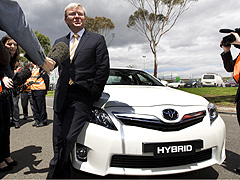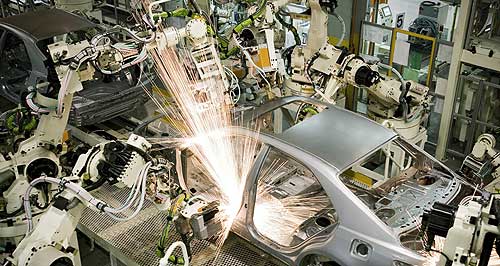Make / Model Search
News - General NewsIndustry slams OECD call to cut auto aidFloored: Australia's peak auto industry body says the OECD has misrepresented the level of government assistance. FCAI claims OECD push for reduced federal auto funding is based on ‘flawed analysis’15 Nov 2010 By TERRY MARTIN THE Federal Chamber of Automotive Industries (FCAI) has slammed a report from the authoritative Organisation for Economic Co-operation and Development (OECD) which takes issue with large Australian government spending programs, including for the car sector. Released last weekend, the OECD’s 2010 economic survey praises the federal government’s handling of the global economic downturn but recommends against further aid to the car industry, arguing that justification for more assistance “has no solid empirical evidence” and that cutbacks in government spending “would also seem desirable”. As a point of reference, the OECD said Australia ranked second among OECD nations – the world’s top economies – in terms of government assistance for the car industry, with federal spending of around $US200 on a per capita basis. This is below Sweden ($245), but well above other countries including, in order, Spain ($122), France ($108), Canada ($100), the UK ($59), the US ($58), South Korea ($54), Italy ($35), Portugal ($28) and Germany ($22). In response, FCAI chief executive Andrew McKellar said he was “disappointed with the flawed analysis of the automotive industry” by the OECD, emphasising that the Australian ranking on international assistance to the automobile sector “utterly misrepresents the extent of investment support to the car industry”. The FCAI argues that the OECD report essentially claims that the federal $6.2 billion New Car Plan for a Greener Future – now said to be down to $5.8 billion – was allocated in one year, not over the next decade. “In short, they have based their assessment on the assumption that investment support to be made available progressively over the next 10 years would be used in one lump sum, in response to the GFC – clearly this is wrong,” Mr McKellar said. “The industry doesn’t have a problem with being accountable but the OECD has the responsibility to base its analysis on solid research. “It is unfortunate that the OECD has relied on this flawed research and it serves as a warning to anyone else considering relying on this data to check their facts. “The reality is, the Australian vehicle market is one of the most open and competitive anywhere in the world, with tariffs on imported vehicles now down to five per cent, at most. “The industry seeks to work co-operatively with the Australian government to attract new manufacturing investment to this country.  Former prime minister Kevin Rudd with Toyota's Camry Hybrid. “Any investment support must be more than matched by industry and must generate net benefits for the Australian economy through employment, increased innovation, R&D and exports. Former prime minister Kevin Rudd with Toyota's Camry Hybrid. “Any investment support must be more than matched by industry and must generate net benefits for the Australian economy through employment, increased innovation, R&D and exports.“The track record of the current policy arrangements speak for themselves with Australian manufacturers successful in securing several significant new investments during a time of international economic uncertainty,” he said. In an interview on ABC radio, federal treasurer Wayne Swan refused to be drawn on whether the government would accept the OECD’s call to rationalise public spending, including for the car industry. “Can I just make this point because this is where the report is very, very supportive of the government,” he told the AM program. “Yes, it does make an entirely sensible point that any government has to have an eye on future expenditure and on financial sustainability, but it overwhelmingly endorses the government's strategy.” The OECD also quoted the Productivity Commission’s ‘Trade and Assistance Review 2008-09’ published earlier this year which reported that total gross assistance to industry reached $17.2 billion – 1.5 per cent of GDP – in 2008/09, including some $7.7 billion in the form of fiscal expenditures. “As rightly stressed by the Productivity Commission over the last years, a large share of these subsidies could be eliminated with beneficial effects for the budget and the economy alike, thanks to reduction of the resultant distortions in resource allocation,” the OECD report said. “This applies, for example, to aid extended to the farm sector during droughts and also aid to the automotive industry. Further assistance to the industry was provided in November 2008, making the total level of subsidies to the Australian automotive industry the second highest in the OECD on a per capita basis. “This package for the automotive industry was released following a continuous period of transitional assistance, which was designed in the mid-1980s, to help the industry adjust to higher competition following the reduction in tariff levels. The transitional assistance did not prevent Mitsubishi in South Australia from leaving the Australian market in 2008. “Justification for subsidies to distressed industries, like the need to offset the appreciation of the Australian dollar or to preserve the technological spillover benefits for other industries, has no solid empirical evidence. “In contrast, such subsidies hinder structural adjustment and the reallocation of resources in the economy made necessary by the changes in relative prices. These adverse effects could worsen over time as a result of the need for structural change due to the emerging mining boom.”  Read more |
Click to shareGeneral News articlesResearch General News Motor industry news |











Facebook Twitter Instagram